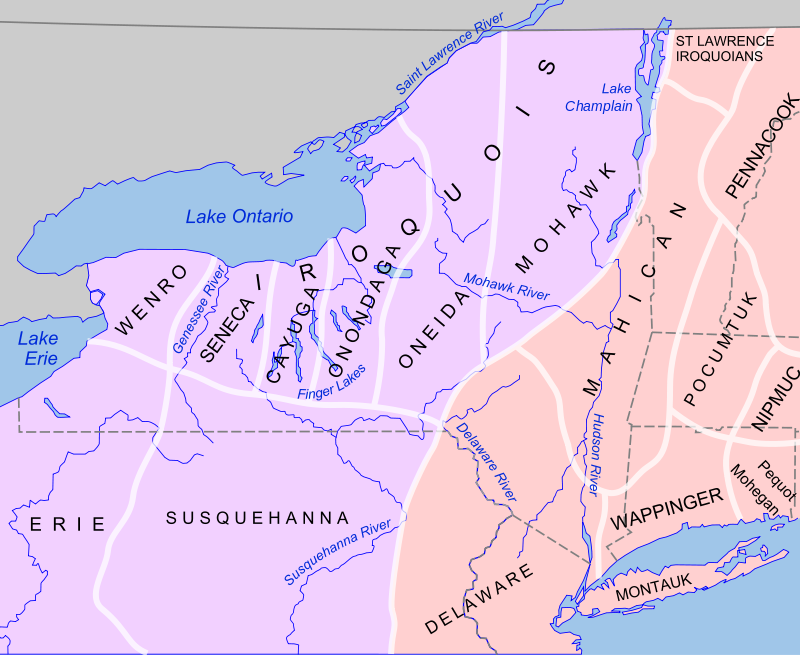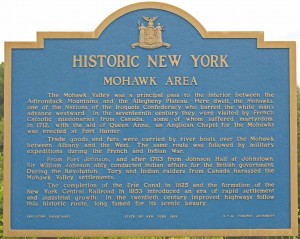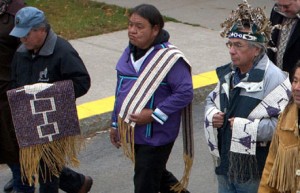
The diminished status of local and state history in New York extends to the first human settlers here as well. First contact between the European colonists and the Indian Nation inhabitants famously begins with Henry Hudson sailing the river the river that flows both ways that now bears his name. Over the course of the next two centuries, from the Hudson to the Erie Canal, the Indian Nations played an important role in the history of the colony and the state. By the time James Fenimore Cooper wrote The Last of the Mohicans: A Narrative of 1757 first published in 1826, that world had vanished: the Canal was completed, New Yorkers had forgotten about the Oneida Nation’s participation in the American Revolution as our allies, and William Johnson had been dead for decades. As one might sing/ask at the end of a musical, “Who will tell their/our story?”
Nearly two centuries later, the Indian Nations are still here. They exist in a vastly different environment and are probably best known for their casinos. They still are viewed as two-dimensional beings although since values have changed sometimes that makes them superior beings as one with nature instead of savages antithetical to civilized beings. Perhaps one day they will become three dimensional and not the victim of stereotypes.
At the annual conference of the Association of Public Historians on New York State (APHNYS) last September in Liverpool, I chose to participate in the field excursion to the nearby Skanonh Lodge Great Law Peace Center. It is part of the Onondaga Nation, the tribe that was at the geographical center of the Haudenosaunee people. Similar centers exist along the Mohawk Valley for other members of the confederation.
During the tour, I asked our tour leader, who is a reader of my posts, about the collaborative efforts with the other facilities. Unfortunately, his reply was negative. Each facility does its own thing.
During past Teacherhostels/Historyhostels, we have visited various sites in the eastern half of the Mohawk Valley related to the Haudenosaunee:
Fenimore Art/Farmers’ Museum
Indian Castle Church
Iroquois Museum
Johnson Hall State Historic Site
Old Fort Johnson
Old Stone Fort
Shrine of Our Lady of Martyrs.
The extension to the western half never materialized. I did scout out the Oriskany Battlefield and Fort Stanwix but never put the pieces together for a program.
Last January, I was an invited guest of the Oneida Nation to participate in workshop at Turning Stone Resort. The purpose of the meeting was to help prepare a grant application to the NEH to produce a documentary on the very Battle of Oriskany. By further coincidence. I previously had been contacted by the Oneida County Historical Society in partnership with the National Park Service which manages the sites of Oriskany and Fort Stanwix (in Rome) about being involved in planning for the 240th anniversary in 2017. I suggested that they along with the New York State site in Little Falls for General Nicholas Herkimer be invited to the Oneida program which they were. Herkimer had bled to death from injuries sustained in the battle. The American general was part of the Palatine settlement in the Mohawk Valley. These Germans too are a forgotten part of American history. By coincidence, the Oneida are popular performers in Germany but the connection with the Palatines in the Mohawk Valley has not been developed.
In a recent newsletter from HISTORIC LEWISTON NEWS, there was an announcement about an upcoming lecture by Neil Patterson, Sr., Tuscarora Council, on “Little Known Facts in Tuscarora History.” The description of the talk is:
Much of the local Tuscarora history has been written by white people, with little or no input from the Tuscaroras. As in any culture, Native American oral traditions run deep and are sometimes reluctantly shared.
The speaker is from the Sand Turtle Clan and a member of the governing Tuscarora Council. He worked as a consultant during the construction of the new Tuscarora Nation House. He has been the coordinator of the Tuscarora Nation Picnic & Field Days for over 30 years. In 2009, he began a four-year collaboration with the Historical Association of Lewiston and the Village and Town of Lewiston to complete the Tuscarora Heroes Monument in time to commemorate the 200th Anniversary of the heroic actions by Nation in saving the lives of local Lewiston settlers.
So here we have an example of another new facility on behalf of one of the Haudenosaunee nations.
I have not been to Ganondagan, the Seneca site near Rochester.
I am not familiar with the Seneca-Iroquois National Museum in Salamanca.
The places mentioned here are not meant to be exhaustive. They suggest the geographic range of possibilities in constructing a Haudenosaunee Path through History in the event anyone should want to do so. The list does not include museums in New York City and Albany which also tell the story.
I would be remiss in this post if I did not mention the North Country. Besides the Fort William Henry, we had the opportunity in a Teacherhostel/Historyhostel to hear Rick Salazar, an Abenaki storyteller, talk with us on Mount Defiance near Fort Ticonderoga. As he was talking a storm moved across Lake Champlain. It was possible to see the comparatively sharp lines between the storm and the sunlight as it traversed the lake. There were moments when we could see sunlight on either side of the storm. It was truly a wondrous sight as it quickly passed. The scene provided a perfect venue to hear about the Abenaki culture. Naturally, I claimed to have arranged for this special effect as part of the program and for no additional charge. I don’t think anyone believed me.
Finally, the Iroquois and the Women’s Right movement were part of the discussion in the plenary address of Sally Roesch Wagner at the second Women’s Suffrage Centennial Conference. In response to my recent post on that conference, Doug George-Kanentiio, a member of the Mohawk Nation, author of Iroquois Culture and Commentary, and vice president of the Hiawatha Institute for Indigenous Knowledge, sent me an article from the Washington Post on that subject. Doug periodically sends me emails in response to my blogs. One was an educator’s guide to the Sullivan-Clinton campaign prepared by Robert Spiegelman. I confess that I don’t know what the status is in the new k-12 social studies guidelines for teaching that campaign. But just as 2017 marks the 240th anniversary of the Battle of Oriskany so 2019 will mark the 240th anniversary of the Sullivan-Clinton campaign. These are opportunities to create culturally enriching programs that bring people to the actual locations of where people in history lived and events occurred and to hear about them in mentally-challenging ways which stimulate thinking.
I regret not having visited the Hiawatha Institute for Indigenous Knowledge in Syracuse when I attended the APHNYS conference in nearby Liverpool. According to its website:
The Hiawatha Institute for Indigenous Knowledge (HIIK) was established on February 19, 2011. The Institute is the fulfillment of a dream first envisioned by the Oneida leader Shenandoah 200 years ago: his wish was to provide a place of learning where the essence of Native knowledge would be shared with the world in a school of higher learning.
A group of contemporary scholars, educators and community leaders have renewed the vision. The group consisted of delegates from the member nations of the Haudenosaunee (Six Nations Iroquois) Confederacy…They were there to do what they could to preserve the culture and traditions of the Haudenosaunee as distinct Native peoples while making available specific instances of our ancestral knowledge to anyone who has a desire to live in harmony with the earth by protecting the rights of those yet to be born onto the seventh generation. Named after one of the creators of the Haudenosaunee Confederacy over 800 years ago, the HIIK will work in partnership with Syracuse University to offer degrees…from a distinct Native perspective in an inclusive curriculum designed by aboriginal knowledge keepers and unique among all institutions of higher learning in North America.
As you can see from this post so far, there are a lot of opportunities and a lot of pieces to be put together to create Haudenosaunee Paths through History. Back then Palatines, Dutch, French, and English weren’t just white people, they were different tribes and nations in their own right; the same applies to the various Indian Nations that are lumped together today. The story of William Johnson attempting to keep the peace among a vast multitude of differentiated peoples is part of the story of New York and American history. The story of James Fenimore Cooper writing when New York had become the Empire State and Johnson’s world was barely a memory also is part of the story of New York and American history. While no venue exists to bring the players together, while there is no leadership from the state, and while there is no funding, one still can envision the possibilities of creating Haudenosaunee Paths through History despite the obstacles to doing so.









